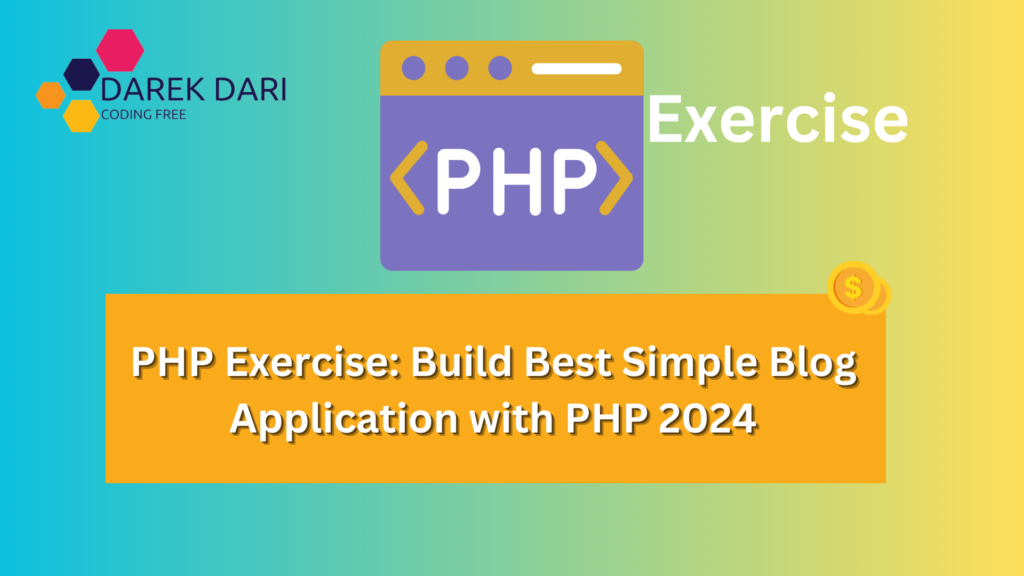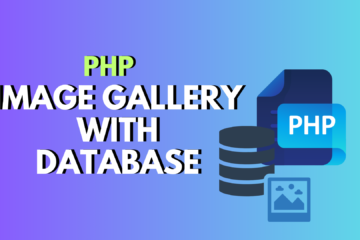
Table of Contents
PHP Projects:
- Quiz Application in PHP
- PHP Image Gallery Project Source Code
- Best 200 Questions Game in PHP
- Bulletin Board PHP Project
- Content Management System (CMS) PhP Project
- Event Management System Project in PHP
- Personal Blog with PHP
- Chatbot in PHP
- URL Shortenee in php
How to create a blog application with PHP?
Let’s develop a basic blog application that allows users to create, view, edit, and delete blog posts. The process will include:
- Environment Setup
- Database and Tables Creation
- Frontend Form Development
- Form Submission Handling
- Blog Post Display
- Blog Post Editing and Deletion
- User Authentication with Sessions.
Here’s an extensive PHP exercise that encompasses various PHP concepts such as variables, control structures, functions, arrays, forms, sessions, file handling, and database interactions. The purpose of this exercise is to create a basic blog application.
What is a blog application?
A blog application is more than just a digital canvas – it’s a powerful platform where you can share your thoughts, experiences, and ideas with the world.
It allows you to create, publish, and manage your own content through blog posts. Whether you’re an expert in your field, an adventurer, or someone with a passion to express, a blog application offers you the space to do so.
Beyond writing, a blog application is a versatile tool that can serve various purposes. It can be a community hub, a marketing tool, a portfolio showcase, and much more.
With features like content management, user authentication, interactivity options, customization tools, and SEO optimization, a blog application enables you to build a unique online presence that mirrors your personality and aspirations.
php exercises
php lab exercises
php mvc folder structure best practices
php mvc framework from scratch
php mvc from scratch
php mvc project
php photo database
php photo gallery
php practice exercises
php project source code
php projects source code
php projects with source code github
php realtime chat
Steps to Code the Simple Blog Application with PHP
Step 1: Setting Up the Playground 🌟
Before we jump into the code, let’s confirm that our playground is ready for action. Make sure you have your trusted local web server (like Apache) with PHP and MySQL installed and set up.
If you need help with this, tools like XAMPP, WAMP, or MAMP can be very useful. Once that’s done, create a new project folder. Let’s call it super_blog.
Make sure you have a local web server (like Apache) with PHP and MySQL installed. You can use XAMPP, WAMP, or MAMP. Create a new project folder, say super_blog.
Step 2: Creating the Database and Tables 🗄️
It’s time to establish a solid foundation! Consider your database as the strong backbone of your blog application. Open up PHPMyAdmin or the MySQL command line and generate a fresh database.
How about giving it a cool name like super_blog? Within this virtual haven, we’ll create a unique space for our blog posts using a clever table. Imagine it as constructing shelves for your cherished book collection!
Fire up PHPMyAdmin or the MySQL command line and create a database:
CREATE DATABASE super_blog;
USE super_blog;Create a table for your blog posts:
CREATE TABLE posts (
id INT AUTO_INCREMENT PRIMARY KEY,
title VARCHAR(255) NOT NULL,
content TEXT NOT NULL,
created_at TIMESTAMP DEFAULT CURRENT_TIMESTAMP
);Step 3: Building the Frontend Form 🖌️
Oh, the empty canvas is ready! This is where we’ll work our magic and create amazing new blog posts. Imagine this as setting up a comfortable writing corner with a comfy chair and a hot cup of coffee.
We’ll add some HTML and PHP to create a form where you can express your thoughts in words. Don’t fret, it’s as simple as baking a batch of cookies (minus the calories).
Create an index.php file in your project folder with this code:
<!DOCTYPE html>
<html lang="en">
<head>
<meta charset="UTF-8">
<title>Super Cool Blog</title>
</head>
<body>
<h1>Create a New Blog Post</h1>
<form action="create_post.php" method="post">
<label for="title">Title:</label><br>
<input type="text" id="title" name="title" required><br><br>
<label for="content">Content:</label><br>
<textarea id="content" name="content" rows="10" cols="30" required></textarea><br><br>
<input type="submit" value="Create Post">
</form>
<hr>
<h1>All Blog Posts</h1>
<?php
include 'db_connection.php';
$sql = "SELECT * FROM posts ORDER BY created_at DESC";
$result = $conn->query($sql);
if ($result->num_rows > 0) {
while($row = $result->fetch_assoc()) {
echo "<h2>" . htmlspecialchars($row['title']) . "</h2>";
echo "<p>" . nl2br(htmlspecialchars($row['content'])) . "</p>";
echo "<p><a href='edit_post.php?id=" . $row['id'] . "'>Edit</a> | <a href='delete_post.php?id=" . $row['id'] . "'>Delete</a></p>";
echo "<hr>";
}
} else {
echo "<p>No posts yet!</p>";
}
$conn->close();
?>
</body>
</html>photo gallery php
php exercises
php exercises and solutions
php exercises and solutions pdf
php exercises online
php lab exercises
php mvc framework from scratch
php mvc from scratch
Step 4: Handling Form Submissions 📬
Picture this as your digital mailbox where all your blog post submissions end up. Let’s create some PHP code to receive those submissions, handle them, and securely save them in our database.
It’s similar to having a helpful mail carrier who guarantees that every letter reaches its intended destination, but in this scenario, our letters are actually blog posts!
Create a create_post.php file to handle form submissions:
<?php
include 'db_connection.php';
if ($_SERVER['REQUEST_METHOD'] === 'POST') {
$title = $_POST['title'];
$content = $_POST['content'];
$sql = "INSERT INTO posts (title, content) VALUES (?, ?)";
$stmt = $conn->prepare($sql);
$stmt->bind_param("ss", $title, $content);
if ($stmt->execute()) {
header("Location: index.php");
exit();
} else {
echo "Error: " . $sql . "<br>" . $conn->error;
}
$stmt->close();
$conn->close();
}
?>Step 5: Displaying Blog Posts 👀
It’s time to share your writing with the world! We’re gathering all the blog posts from our database to display them on the webpage.
Think of it as hosting your own poetry slam, but instead of snapping fingers, we’ll be clicking links and scrolling through amazing pieces.
This part is already handled in the index.php file where we fetch and display all blog posts. Sweet!
Step 6: Editing and Deleting Blog Posts ✏️❌
Oh, the magic of writing! Or in this scenario, the wonders of typing. With this feature, we can enhance our blog posts by adding the ability to edit and delete them.
It’s like having a personal editor, but instead of using red pens, all it takes is a few lines of code. You’ll have the power to refine your posts or say goodbye to the ones that have fulfilled their purpose.
Create an edit_post.php file for editing posts:
<?php
include 'db_connection.php';
if (isset($_GET['id'])) {
$id = $_GET['id'];
$sql = "SELECT * FROM posts WHERE id = ?";
$stmt = $conn->prepare($sql);
$stmt->bind_param("i", $id);
$stmt->execute();
$result = $stmt->get_result();
if ($result->num_rows === 1) {
$post = $result->fetch_assoc();
} else {
echo "Post not found!";
exit();
}
} elseif ($_SERVER['REQUEST_METHOD'] === 'POST') {
$id = $_POST['id'];
$title = $_POST['title'];
$content = $_POST['content'];
$sql = "UPDATE posts SET title = ?, content = ? WHERE id = ?";
$stmt = $conn->prepare($sql);
$stmt->bind_param("ssi", $title, $content, $id);
if ($stmt->execute()) {
header("Location: index.php");
exit();
} else {
echo "Error: " . $sql . "<br>" . $conn->error;
}
} else {
echo "Invalid request!";
exit();
}
$stmt->close();
$conn->close();
?>
<!DOCTYPE html>
<html lang="en">
<head>
<meta charset="UTF-8">
<title>Edit Post</title>
</head>
<body>
<h1>Edit Blog Post</h1>
<form action="edit_post.php" method="post">
<input type="hidden" name="id" value="<?php echo htmlspecialchars($post['id']); ?>">
<label for="title">Title:</label><br>
<input type="text" id="title" name="title" value="<?php echo htmlspecialchars($post['title']); ?>" required><br><br>
<label for="content">Content:</label><br>
<textarea id="content" name="content" rows="10" cols="30" required><?php echo htmlspecialchars($post['content']); ?></textarea><br><br>
<input type="submit" value="Update Post">
</form>
</body>
</html>Create a delete_post.php file for deleting posts:
<?php
include 'db_connection.php';
if (isset($_GET['id'])) {
$id = $_GET['id'];
$sql = "DELETE FROM posts WHERE id = ?";
$stmt = $conn->prepare($sql);
$stmt->bind_param("i", $id);
if ($stmt->execute()) {
header("Location: index.php");
exit();
} else {
echo "Error: " . $sql . "<br>" . $conn->error;
}
$stmt->close();
$conn->close();
} else {
echo "Invalid request!";
}
?>Step 7: Using Sessions for User Authentication 🔐
It’s time to secure your blog kingdom by locking the doors! Let’s sprinkle some session magic to verify users. Think of it as a special handshake to join an exclusive club.
Only those with the correct credentials can explore the inner workings of your blog empire.
Create a login.php file for user login:
<?php
session_start();
include 'db_connection.php';
if ($_SERVER['REQUEST_METHOD'] === 'POST') {
$username = $_POST['username'];
$password = $_POST['password'];
$sql = "SELECT * FROM users WHERE username = ? AND password = ?";
$stmt = $conn->prepare($sql);
$stmt->bind_param("ss", $username, $password);
$stmt->execute();
$result = $stmt->get_result();
if ($result->num_rows === 1) {
$_SESSION['username'] = $username;
header("Location: index.php");
exit();
} else {
echo "Invalid username or password!";
}
}
$stmt->close();
$conn->close();
?>
<!DOCTYPE html>
<html lang="en">
<head>
<meta charset="UTF-8">
<title>Login</title>
</head>
<body>
<h1>Login</h1>
<form action="login.php" method="post">
<label for="username">Username:</label><br>
<input type="text" id="username" name="username" required><br><br>
<label for="password">Password:</label><br>
<input type="password" id="password" name="password" required><br><br>
<input type="submit" value="Login">
</form>
</body>
</html>Update index.php to include session checks:
<?php
session_start();
if (!isset($_SESSION['username'])) {
header("Location: login.php");
exit();
}
?>
<!DOCTYPE html>
<html lang="en">
<head>
<meta charset="UTF-8">
<title>Super Cool Blog</title>
</head>
<body>
<h1>Welcome, <?php echo htmlspecialchars($_SESSION['username']); ?>!</h1>
<a href="logout.php">Logout</a>
<hr>
<!-- Rest of the code remains the same -->
</body>
</html>Create a logout.php file:
<?php
session_start();
session_unset();
session_destroy();
header("Location: login.php");
exit();
?>Create a db_connection.php file to handle your database connection:
<?php
$servername = "localhost";
$username = "root";
$password = "";
$dbname = "super_blog";
// Create connection
$conn = new mysqli($servername, $username, $password, $dbname);
// Check connection
if ($conn->connect_error) {
die("Connection failed: " . $conn->connect_error);
}
?>Bonus: User Registration (Because You’re Awesome!) 🎉
Finally, it’s time to extend a warm welcome! By enabling user registration, you can extend invitations to fellow bloggers and encourage them to become part of your community.
It’s just like hosting a fabulous grand opening party for your blog. Remember, the more, the merrier!
Create a register.php` file for new users to register:
<?php
include 'db_connection.php';
if ($_SERVER['REQUEST_METHOD'] === 'POST') {
$username = $_POST['username'];
$password = $_POST['password'];
$sql = "INSERT INTO users (username, password) VALUES (?, ?)";
$stmt = $conn->prepare($sql);
$stmt->bind_param("ss", $username, $password);
if ($stmt->execute()) {
header("Location: login.php");
exit();
} else {
echo "Error: " . $sql . "<br>" . $conn->error;
}
$stmt->close();
$conn->close();
}
?>
<!DOCTYPE html>
<html lang="en">
<head>
<meta charset="UTF-8">
<title>Register</title>
</head>
<body>
<h1>Register</h1>
<form action="register.php" method="post">
<label for="username">Username:</label><br>
<input type="text" id="username" name="username" required><br><br>
<label for="password">Password:</label><br>
<input type="password" id="password" name="password" required><br><br>
<input type="submit" value="Register">
</form>
</body>
</html>Add a users table to your database:
CREATE TABLE users (
id INT AUTO_INCREMENT PRIMARY KEY,
username VARCHAR(50) NOT NULL UNIQUE,
password VARCHAR(255) NOT NULL
);Congrats! You’ve built a super cool blog app that handles posts, user authentication, and more. Happy coding! 🎉🚀
php mvc project source code
php photo database
php photo gallery
php project source code
php projects source code
php projects with source code
php real time application
php real time chat application
php realtime chat
Can I use a PHP script in Blogger?
Blogger, Google’s popular blogging platform, does not have built-in support for PHP scripts. It mainly works with static HTML and JavaScript in posts and pages.
However, there are ways to get around this limitation. One option is to host your PHP scripts on a server that supports PHP, such as a shared hosting provider or a virtual private server (VPS).
After uploading them, you can then link to these scripts from your Blogger content. Another possibility is to embed PHP-powered content using an tag.
This method involves creating a separate PHP-powered webpage and embedding it into your Blogger site. Additionally, some third-party services provide tools and widgets that can generate dynamic content without server-side scripting.
You can include their embeddable code snippets in your Blogger posts or pages to incorporate interactive elements or forms.
Even though Blogger doesn’t directly support PHP scripting, these workarounds allow you to add dynamic functionality to your blog, enhancing engagement and interactivity.
php exercises and solutions
php exercises and solutions pdf
php projects with source code
php source code projects
Is PHP website good for SEO?
Yes, think of PHP as the secret ingredient that spices up your website’s SEO game. It’s like having a reliable partner that assists you in creating dynamic and captivating content that search engines can’t resist.
Imagine PHP as your digital fairy godmother, fulfilling wishes for dynamic content creation. Its capabilities allow you to develop web pages that transform and adjust based on user interactions or database queries.
It’s akin to possessing a magical tool that keeps your content fresh and engaging, something that search engines truly appreciate.
And let’s not overlook the importance of SEO-friendly URLs! With PHP, you can design URLs that are as clear and descriptive as a brand-new banknote. It’s like presenting search engines with a roadmap that leads directly to your website’s content treasure trove.
Moreover, PHP seamlessly integrates with databases like MySQL, simplifying the process of storing and retrieving content.
Need to showcase a wide range of products on your online store? PHP has got your back, converting database queries into dynamic product pages that shine like diamonds in the eyes of search engines.
Oh, and speed? PHP races through the online realm quicker than a superhero on a mission. Combine it with clever caching techniques and optimization strategies, and you’ll have a website that loads faster than you can say “SEO success!”
Let’s not forget about the life of the party in the SEO realm – plugins and tools! With PHP-powered CMS platforms like WordPress, you have a plethora of plugins at your fingertips.
They act as little helpers that sprinkle magic on your website, optimizing meta tags, creating XML sitemaps, and even incorporating fancy schema markup.
PHP and SEO make the ultimate dream team, collaborating to elevate your website to the pinnacle of search engine rankings. With PHP as your ally, your website will become the talk of the town in no time! 🚀.
Do people still use PHP for websites?
Absolutely! PHP is thriving in the world of web development. It’s like that dependable friend who’s been around the block and knows all the tricks of the trade.
While there are newer options like Node.js and Python, PHP continues to hold its ground. It powers a significant portion of the internet, including big names like Facebook, WordPress, and Wikipedia.
It’s the backbone of the web, quietly doing its job without stealing the spotlight.
Why do people still choose PHP? Well, for one, it’s incredibly versatile. Whether you’re creating a simple blog or a complex e-commerce platform, PHP can handle it all.
It’s like a Swiss Army knife for web development, offering a wide range of libraries, frameworks, and tools.
Moreover, PHP seamlessly integrates with databases like MySQL, making it perfect for building dynamic, data-driven websites. Need to retrieve user data from a database? PHP has got you covered, transforming queries into dynamic web pages.
And let’s not forget about the vibrant PHP community. It’s like a bustling marketplace, where developers share code snippets, troubleshoot together, and exchange best practices.
If you ever encounter a tricky PHP problem, just reach out to the community, and someone will come to the rescue.
In conclusion, people still rely on PHP for websites, and for good reason. It may not be the newest trend, but it’s dependable, versatile, and supported by a passionate community. So don’t underestimate PHP – it’s here to stay!
What is the best app to start a blog?
Choosing the right app to start a blog depends on what you’re looking for. Here are some popular options:
- WordPress: WordPress is a widely used blogging platform that offers flexibility, customization options, and ease of use. Whether you’re a beginner or an experienced blogger, WordPress provides a user-friendly interface and a wide range of themes and plugins to help you create and customize your blog.
- Blogger: Blogger is a free blogging platform provided by Google. It’s known for its simplicity and ease of use, making it a great choice for beginners. With Blogger, you can quickly set up a blog and start publishing content without any technical knowledge.
- Medium: Medium is a blogging platform that focuses on writing and storytelling. It has a clean and minimalist interface, making it easy to create and publish content. Medium also has a built-in audience of readers, which can help your blog gain exposure and reach a wider audience.
- Wix: Wix is a website builder that includes blogging functionality. It offers a drag-and-drop interface and a variety of templates, making it easy to create a visually appealing blog without any coding skills. Wix also provides features for SEO optimization and e-commerce integration.
- Ghost : Ghost is a blogging platform that prioritizes simplicity and performance. It boasts a sleek and contemporary interface, tailor-made for bloggers and publishers. With Ghost, you can enjoy various features such as membership and subscription options, email newsletters, and analytics. It’s an excellent choice for bloggers aiming to cultivate a devoted following and generate revenue from their content.
Consider your specific needs, preferences, and goals when choosing the best app for your blog.
Related searches
- Simple blog application sample
- Simple blog application template
- Simple blog application example
- blog web application example
- blogger
- blog-app android studio github
- full-stack blog-website github
- simple blog website
FAQ
- What is Simple Blog Application with PHP?
Simple Blog Application with PHP is a user-friendly and lightweight platform that enables you to effortlessly create and manage your own blog. It is built using PHP, providing a hassle-free and straightforward approach to blogging, making it an excellent choice for beginners and those seeking a seamless blogging experience. - How can I get started with Simple Blog Application with PHP?
Starting with Simple Blog Application with PHP is a breeze! Just download the application, follow the installation instructions, and you’ll be up and running in no time. Once installed, you can immediately begin crafting and publishing your blog posts. - What features does Simple Blog Application with PHP offer?
Simple Blog Application with PHP offers a range of essential features for blogging, including:- A user-friendly interface for effortlessly creating and managing blog posts
- Support for categories and tags to effectively organize your content
- User authentication for secure access to the admin dashboard
- A commenting system to actively engage with your readers
- SEO-friendly URLs for enhanced search engine visibility
- Customization options to personalize the appearance and feel of your blog
- Is Simple Blog Application with PHP suitable for beginners?
Absolutely! Simple Blog Application with PHP is specifically designed with beginners in mind. Its intuitive interface and straightforward setup process make it an ideal choice for individuals who are new to blogging or web development. You’ll be blogging like a pro in no time! - Can I customize the design of my blog using Simple Blog Application with PHP?
Certainly! Simple Blog Application with PHP allows you to easily customize the design and layout of your blog. You can select from a variety of pre-designed templates or even customize the CSS to create a unique and personalized look that perfectly reflects your personal style.
Conclusion
In summary, Simple Blog Application with PHP provides a user-friendly and easy-to-use platform for creating and managing your very own blog.
Its intuitive interface, essential features, and customization options make it ideal for beginners and anyone looking for a stress-free blogging experience.
Whether you’re a casual blogger, a small business owner, or an aspiring writer, Simple Blog Application with PHP enables you to express your thoughts, stories, and ideas with the global audience.
Plus, its open-source nature allows you to personalize, contribute, and truly make it your own.
Don’t hesitate any longer – get Simple Blog Application with PHP today and start sharing your voice with the world! 🚀📝.




0 Comments